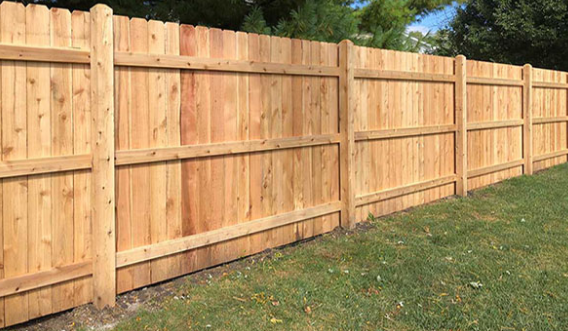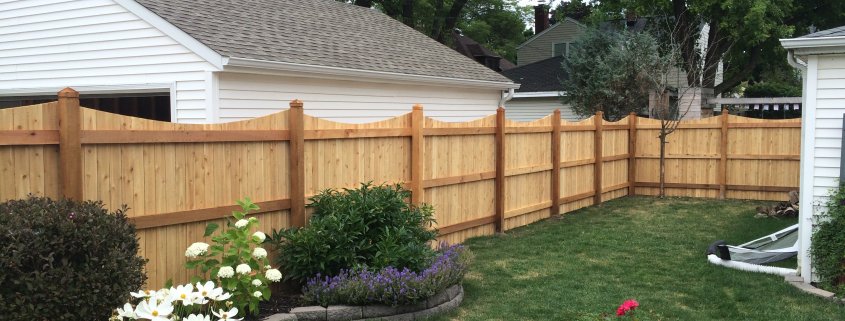Reliable Wood Fence Contractors Fort Smith AR: Customized Fencing Options for Your Home
Reliable Wood Fence Contractors Fort Smith AR: Customized Fencing Options for Your Home
Blog Article
Step-by-Step Overview to Setting Up a Wood Fencing for Your Home or Residential Or Commercial Property
Mounting a wood fence can considerably improve both the performance and aesthetic charm of your property. Recognizing these steps not only makes sure a strong installment but likewise contributes to lasting complete satisfaction.
Preparation Your Fence Setup
When embarking on the installment of a wood fencing, careful planning is essential to make sure an effective result. Begin by examining the function of the fencing-- whether it is for personal privacy, safety and security, or aesthetic appeals-- since this will certainly affect the style and format. Next, evaluate the residential property lines, making sure to confirm the limits through a survey or title deed to prevent conflicts with next-door neighbors.
Think about local zoning home owners and legislations' organization standards, as these might determine fence height, layout, and materials. It is suggested to acquire the needed licenses prior to starting work, as this can avoid lawful problems later on.
Moreover, take into consideration the terrain and soil conditions of your residential property. Unequal ground may need additional adjustments during installation, while rocky dirt could necessitate customized devices.
Last but not least, develop an in-depth plan that consists of dimensions, the variety of blog posts, and the spacing between them. A clear format will certainly facilitate the installment procedure and ensure that you have all called for materials accessible. By sticking to these planning actions, you can set a strong structure for an effective wood fence installation.
Picking the Right Products
Picking the proper materials for your timber fence is vital to ensuring sturdiness and visual allure. One of the most usual kinds of timber made use of for secure fencing include cedar, redwood, and pressure-treated pine. Cedar and redwood are naturally immune to degeneration and pests, making them superb choices for long life. Their rich colors and all-natural grain patterns additionally enhance the visual allure of your property.
Pressure-treated want is one more prominent option, as it is frequently extra cost effective. It needs regular upkeep and therapy to lengthen its lifespan. When selecting wood, think about the climate of your area; for instance, areas with high humidity may benefit from timber species with higher resistance to dampness.
In addition, you need to review the fence design and purpose. A picket fence might require different material specifications contrasted to a privacy fencing. Select thicker boards for structural integrity, particularly in high-wind areas. Consider the finish; neglected wood may need staining or securing to protect versus weather elements. By very carefully picking your materials, you can guarantee that your timber fencing will certainly stand the test of time while complementing your home's landscape.
Preparing the Setup Website

Preparing the installation website is a critical step in ensuring the successful building of your wood fence. Proper preparation not just facilitates a smoother installment process yet also adds to the longevity and stability of the fencing.

Following, analyze the terrain. Remove any type of barriers such as rocks, roots, or particles that can prevent the installment procedure. If your site has irregular ground, consider leveling it or adjusting your fencing layout accordingly. In addition, look for underground energies by calling your local energy firm. This is important to stop damage during installment and guarantee safety and security.
Setting Up the Fencing Articles

Next, dig openings for each and every blog post, guaranteeing they are deep enough-- typically one-third the height of the blog post over ground-- to supply stability. A deepness of at the very least 2 feet is a good idea for the majority of fences. The size of the holes must be roughly 3 times the size of the blog posts.
Once your holes are ready, place each blog post upright right into the assigned opening. Make use of a level to guarantee they are plumb, changing as needed. After placing, fill up the holes with concrete click for more mix or packed soil for added assistance. Permit the concrete to cure as per the producer's directions, generally 24 to 48 hours. Appropriately mounted articles are crucial for keeping the architectural integrity of the fence, ensuring it stays upright and safe and secure versus environmental tensions.

Adding Fence Panels and Finishing Touches
Once the fencing articles are safely set, the next step involves connecting the fencing panels, which will define the limits of your property. Begin by placing each panel in between the blog posts, guaranteeing they are level and straightened. Make use of a degree tool to examine that the panels are straight; this will certainly ensure a specialist finish. For ideal security, protected each panel to the blog posts using galvanized screws or nails, which stand up to rust and deterioration.
After all panels are affixed, examine the entire fencing for any type of gaps or misalignments. Make changes as required to guarantee an uniform look.
In addition, applying a protective stain or sealant will certainly enhance the timber's resilience versus weather aspects, prolonging the life of your fencing. Pick a color that complements your home and landscape for a visually pleasing appearance. Lastly, inspect regional laws for any type of required maintenance or updates to ensure compliance with area standards. With these steps, your wood fencing will not only offer its objective successfully however additionally boost the overall appeal of your building.
Verdict
In verdict, the successful setup of a timber fence calls for mindful planning, selection of suitable products, comprehensive site prep work, and accurate execution of installation strategies. Appropriate upkeep post-installation better extends the life and appearance click here for more info of the timber fence.
When embarking on the setup of a wood fencing, careful planning is crucial to make sure an effective result.Picking the suitable materials for your wood fencing is critical to ensuring sturdiness and aesthetic allure. A picket fencing may need different product specs compared to a personal privacy fencing.With the installation website correctly prepared, the following step includes setting the fence blog posts, which serve as the foundation of your wood fencing.As soon as the fencing articles are safely established, the following step includes connecting the fencing panels, which will certainly specify the limits of Recommended Site your property.
Report this page